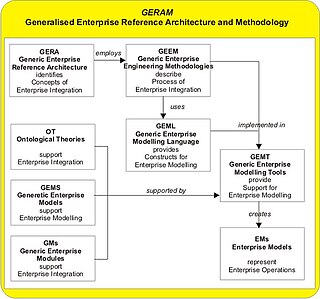1980s
Concept
The concept of business architecture emerged in the 1980s in the field of information systems development. One of the first to mention business architecture was the British management consultant Edwin E. Tozer in the 1986 article "Developing strategies for management information systems." [9] He introduced the concept of business architecture in the context of business information systems planning, and distinguished:
- Business architecture, and
- Information architecture,
And he explained, that "each entity class in the Information Architecture is represented in some database and each business function may be supported by one or more systems." [9] In this paper Tozer was "prescriptive about the order in which [strategy] issues should be identified.", [10] and focussed on "IS adaptability to organizational strategies." [11]
First models
The American organizational theorist William R. Synnott (1987) presented one of the first models of business architecture, (see image), in the context of data management. Synnott wanted to develop an overall Information Resource Management (IRM) architecture, and proposed business architecture as its foundation. He described:

Business architecture is the foundation upon which the IRM architecture rests. The architectural model consists of a set of building-blocks of linked architectures which together form the basis for the technology infrastructure of the firm... In the figure data architecture and communication architecture are shown as horizontal bars because these are corporate-wide information resource components. They serve all business units. The four vertical resource components are business specific. The resources can be divided according to the business units they serve. That us, data and communication might be centralizes resources, whereas human resources (professional systems staffs), computers, user-computing, and systems could all be decentralized resources to one degree or another. [12]
This model of Information Resource Management (IRM) distinguished seven types of architecture:
- Centralized: Business architecture, Data architecture, and Communication architecture
- Decentralized : Human resources architecture, Computer architecture, User-computing architecture, and Systems architecture.
This type of architectural model classifies different types of architecture. In the later theories and models different sets of architectures have been proposed. For example, the late 1980s NIST Enterprise Architecture Model distinguished five types, and this was incorporated in the 1990s Federal Enterprise Architecture, which contained four types of architecture.[ citation needed ]
Base for the total development process
Synnott (1987) furthermore described, how business architecture should work and introduced the idea of architectural planning:
The business architecture of the company (organization structure, strategic business units and missions, product and services) is the foundation of IRM planning. Since every company has an existing architecture, architectural planning begins with an inventory of the firm's information resources. Assembling the various information resource components' inventories results in an "as is" picture of the corporation's technology structure. From this inventory, the CIO can analyze the strengths and weaknesses of the company's information resources, particularly as they relate to business information needs as identified in the strategic planning process. From this analysis one can evolve an architectural plan, which is a "to be" picture of where one wants to go and how to get there, not just a picture of the status quo. [12]
Cees J. Schrama. (1988) of the European IFIP Technical Committee on Information Systems IFIP TC8 presented the opinion, that "business architecture is required to provide a solid base for the total development process." He pictured another model consisted of elements such as information processing architecture and network architecture, and explained:
[Business architecture] contains the fundamentals for the information processing architecture, where process data, support systems and network architecture are performed. In business architecture the following can 'be identified:
- - enterprise analysis: to indicate the business domains
- - business analysis
- - Information systems planning
There are some basic elements in business architecture: management, organization, processes to be performed and data to be made available/delivered. In the past, when mainly operational systems were developed, the processes received considerable attention. Information was seen as being needed to perform processes. This is changing. It is becoming important to have data available to serve information retrieval needs as well. [13]
These ideas around the concept of architectural planning evolved in the early 1990s into frameworks, such as TAFIM, the predecessor of TOGAF.
View models of enterprise architecture
In the 1987 article "A Framework for Information Systems Architecture" John Zachman presented some of the principles of Enterprise architecture, [14]
Framework for information systems architecture

In the 5th NIST workshop on Information Management Directions (1989) a working groups under guidance of W. Bradford Rigdon developed one of the first Enterprise Architecture frameworks, the NIST Enterprise Architecture Model. In this model business architecture was incorporated as one of the layers of Enterprise Architecture. Bradford Rigdon et al. (1989) brought it like this:
A discussion of architecture must take into account different levels of architecture. These levels can be illustrated by a pyramid, with the business unit at the top and the delivery system at the base. An enterprise is composed of one or more Business Units that are responsible for a specific business area. The five levels of architecture are
- Business Unit
- Information
- Information System
- Data
- Delivery System
The levels are separate yet interrelated... The idea if an enterprise architecture reflects an awareness that the levels are logically connected and that a depiction at one level assumes or dictates that architectures at the higher level. [15]
In the original 1989 illustration of the NIST AE Framework (see image) the top layer was named "Business Unit Architecture." In representation of this model in the 1990s the top layer was named "Business architecture."



















